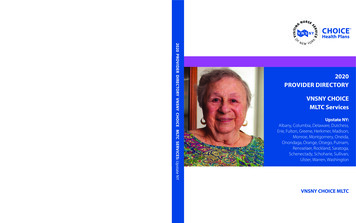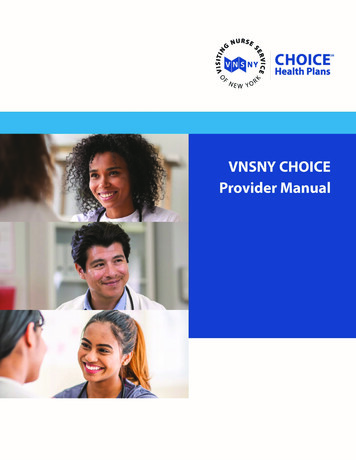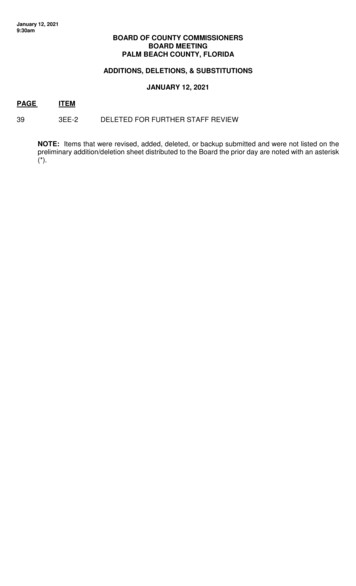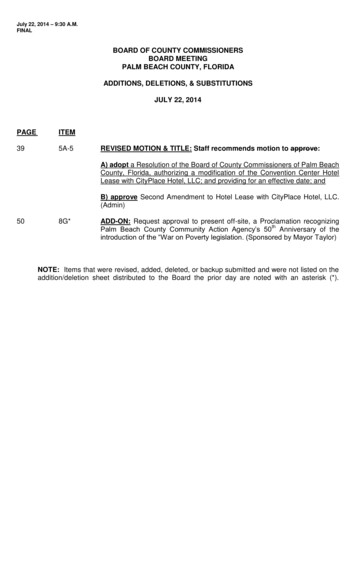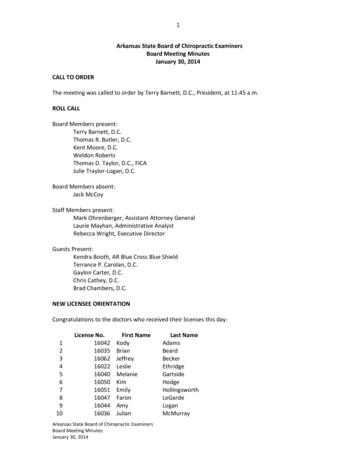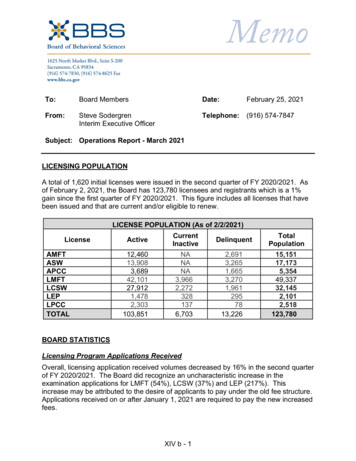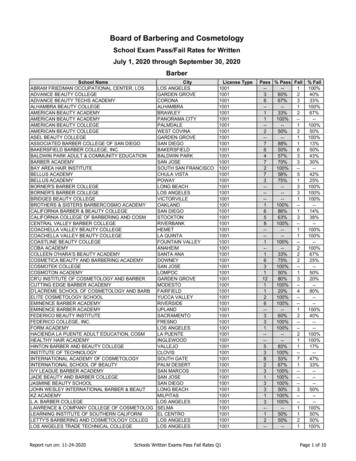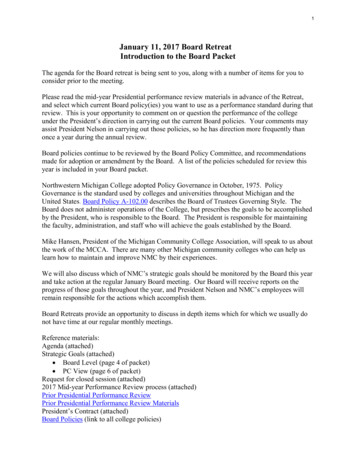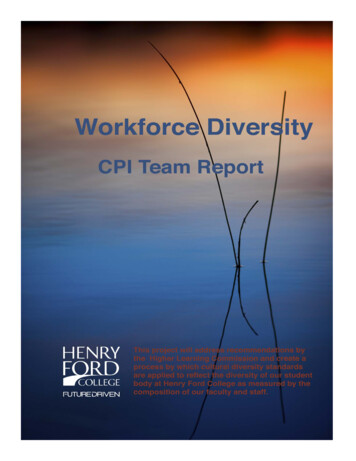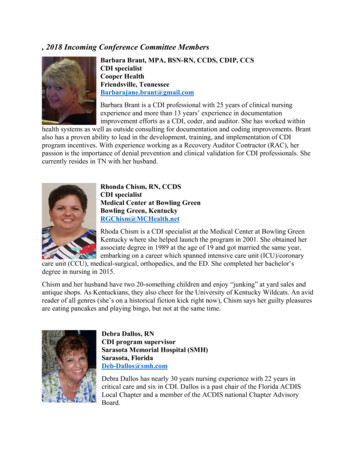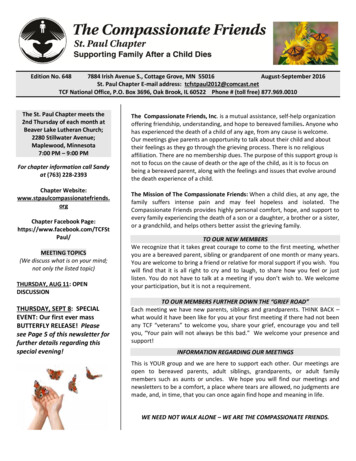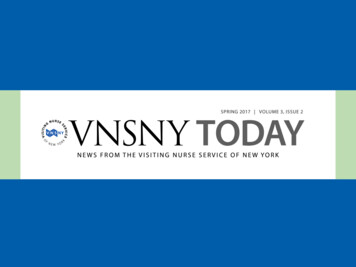
Transcription
VNSNY Board Members AreAmong United Hospital FundHonoreesVNSNY Board Members Carl Pforzheimer III and Anne Ehrenkranzwere among the trustees honored by the United Hospital Fund (UHF)on May 1st at the fund’s Distinguished Trustee Awards luncheon. TheUHF awards are presented to trustees from health care organizationsin the New York metropolitan area who have displayed extraordinaryleadership and service.Pforzheimer was recognized for his 43 years on the VNSNYBoard, while Ehrenkranz’s award was presented in recognition of herwork with the Hospital for Special Surgery, on whose board she alsoserves. This was the first year that the UHF has honored trustees fromhome care agencies and nursing homes in addition to hospital trustees.SPRING 2017Carl Pforzheimer III and Anne EhrenkranzIn an open letter to the VNSNY staff, Pforzheimer noted that theorganization’s mission of helping the vulnerable “is why VNSNY waschosen to be the first home health care agency to be included in theUnited Hospital Fund event.” He added, “As I also understand it, Iwas suggested by the staff of VNSNY as the person to accept thehonor as a VNSNY trustee. That made it a double honor for me, sinceI know after many years on the VNSNY Board that the staff is theheart and soul of the agency.”2
VNSNY’s Mental Health Division TrainsNYC Public School StaffVNSNY’s Community Mental Health Services (CMHS) hasbeen awarded a three-year grant by New York City to providebehavioral health training to teachers and administrators in 40public schools. In the program, CMHS social workers arecoaching the staff of public schools in methods for managingchildren in crisis and enhancing their students’ overallpsychological health and academic performance.“The city reached out to us based on the success of ourPromise Zone program in the Bronx, where we work directlywith children in public schools,” says Devon Bandison,Director of Children’s Services for CMHS. The city-wideprogram, called “100 Schools,” is providing coaches to 20selected schools in each of the city’s five boroughs. VNSNYwill be servicing the initiative’s 40 schools in Brooklyn andQueens, with ten coaches handling four schools each under thesupervision of CMHS Program Coordinator Eric Schlothan.Each coach will visit one school per day to work withsmall groups of teachers and administrators, teaching themeverything from how to create an environment of positivereinforcement in the classroom to techniques for deescalating achild who is in emotional or psychological crisis. “Most publicschool teachers have never been trained in specific behavioraltechniques,” explains Bandison. “People talk about a difficultclass or a difficult school, but in many cases it’s just an issueof a few children who are struggling. Having our staff come inand explain how to handle and manage these behaviors bychildren really empowers educators. It gives them tools towork more effectively with their students, and teaches themhow to create a more supportive environment where childrencan really thrive.”SPRING 2017In a new city-funded program, CMHS socialworkers are training public school teachers andadministrators in methods that support children’spsychological well-being.Above: VNSNY psychiatric social worker YennisColon, right, confers with Dannielle Darby, principalof the Brooklyn Academy of Global Finance HighSchool, one of the participating schools.Left photo: Colon with Sarah McCoy, the assistantprincipal of the school.3
An Interview with VNSNY’s Chief Information OfficerRobert Plaszcz Discusses Moving to the Cloud and Other IT InitiativesVNSNY’s IT department has been workingon quite a few projects. Can you tell usabout some of them?One of our latest projects is a new population healthprogram launched earlier this year. Our IT teamdesigned software that lets us transmit data from ourcurrent Provider Operations electronic medicalrecords (EMR) system directly into AltruistaGuidingCare, our care management platform. Byintegrating these records within GuidingCare, ourpopulation health coordinators can now get a full360-degree picture of what’s going on with eachpatient, allowing them to manage patients’ caremore effectively. This is especially important as weincreasingly enter into Case Rate arrangements withprivate insurers, in which we are working to keeppatients with complex conditions home and out ofthe hospital. This integrated platform makes it easierto quickly identify problems or issues with a givenpatient.Are there other developments regardingcare management software or EMR?Absolutely. We also incorporated a new, simplerpatient risk stratification score into GuidingCarethat our population health team developed. Andthroughout 2017, we’ll be doing monthly releases ofad di ti on al en h an cemen t s t o G ui din gC are .Additionally, on the Provider side of theorganization, we are teaming with Operations toevaluate options for our future EMR system. We’reexcited to be part of this effort, which will let usdeliver care more effectively and provide enhancedadministrative efficiencies.What about VNSNY CHOICE-related projects?CHOICE recently went live with a new grievance andappeals management system, called OnBase. Itreplaces our internally developed database, which hasbecome outdated. The new system will help theCHOICE Grievance & Appeals team process cases ina more timely and efficient manner, and also improvesthe ability of their colleagues in Member Services andUtilization Management to know if and when anappeal has been filed.Could you update us on the plans to movevarious VNSNY operations into the cloud?Cloud services are nothing new at VNSNY. We’recontinually evaluating how and where to deliver thebest service possible to those we serve. Currentlywe’re using several platforms that are cloud-basedand/or subscription-based. We’re also movingVNSNY’s email services into the cloud as part of theMicrosoft 365 software solution we’re implementingacross the organization. That should be completedwithin the next three months. We’ll be doing the samewith SharePoint in the near future. This change willsave on storage, because we won’t have to maintainour own servers, and give us more flexibility in termsSPRING 2017“We’re continually evaluating how and where todeliver the best service possible to those we serve,”says Robert Plaszcz, VNSNY’s Chief InformationOfficer.of emergency preparedness. And it will allow us toprovide services more quickly for the business. Wealso just completed moving all VNSNY’s deskphones to a Verizon cloud service. Besides reducingcosts, the Verizon cloud has a data backup that wecan switch to if a problem arises. And if people haveto move their office location, you can take yourphone and plug it anywhere in the VNSNY system,and it will remember who you are. We hope to addSkype capabilities to the phones as well.Are there any other IT projects coming downthe pike?There are. We’ll also be rolling out new iPhones toall of our staff shortly. We're hoping to includesome new apps for ride-sharing and traffic guidance,and some clinical apps that didn’t exist on our oldWindows platform. We don’t have an exact date yet,but they’ll be coming sometime this calendar year.4
A Win for Everyone: Congressman Adriano EspaillatVisits VNSNY CHOICE MLTC MemberAs Lorenzo Nieves sits in his wheelchair, Soraya Gomez, a VNSNY nurse,stands attentively by his side. A short time earlier, she had checked Nievesto make sure no worrisome symptoms had arisen since her previous visit.Now she keeps watch over her patient as he chats with his special guest:Congressman Adriano Espaillat, who represents New York’s 13thDistrict—an area stretching from Manhattan’s Upper West Side andHarlem up through Washington Heights in northern Manhattan and a sliceof the Bronx.The fact that Rep. Espaillat can visit Nieves in his apartment is a winfor everyone, since Nieves has multiple chronic conditions that place him athigh risk for hospitalization. In July 2016, after yet another of his manyinpatient stays, he was referred to VNSNY’s Managed Long Term Care(MLTC) plan. Since then, his health has improved substantially thanks tothe ongoing care coordination provided by nurse Gomez and otherCHOICE staff, combined with the daily assistance provided by the personalcare worker whose services are included in the CHOICE MLTC healthplan’s benefits.Working together, the interdisciplinary care team has kept Nieves out ofthe hospital for almost a full year. “He used to go the hospital once amonth,” notes Gomez. “But since we took on his care, he hasn’t had to goto the hospital once.”For Rep. Espaillat, this visit is a chance to thank VNSNY and Gomezfor keeping his constituent safely at home and away from the emergencyroom. Last year, approximately 15,000 people in the 13th District receivedhome care services through VNSNY. Another 1,000 of his constituentsreceived VNSNY home hospice services in 2016.SPRING 2017U.S. Representative Adriano Espaillat (left) paying a visit to CHOICEMLTC member Lorenzo Nieves (center) and VNSNY nurse Soraya Gomez.“I’m grateful to VNSNY for the invaluable home health care services itprovides,” says Rep. Espaillat.“I was delighted to visit,” Rep. Espaillat said, as he bid goodbye to Mr.Nieves. “I’m grateful to VNSNY for the invaluable home health careservices it provides to our residents, especially to our seniors andindividuals in need. I’m committed to ensuring that we enact policies inCongress that continue to address and support the need for quality, costeffective professional home care that benefits us all.”5
New Phone App for HHAs Saves Time and EnhancesMedical Record-KeepingWhen Shannon Reid, a home health aide (HHA) with VNSNY’sprivate-pay division Partners in Care, was first enlisted to help pilota new smartphone app designed to streamline her workflow, she felta little daunted by the technology. Once she received training in theapp’s use and found out how easy and convenient it was to operate,however, her hesitancy quickly turned to appreciation.“It saves me a lot of time,” she says now. In addition toproviding contact information and directions for each client, the newapp also uses the phone’s GPS function to inform Partners in Careautomatically when Reid arrives at each client’s home, and containsa plan-of-care checklist. “Before, I had to call in to my supervisor tosay that I’d arrived, and then call back at the end of the shift toreport on all the tasks I’d performed,” she notes. “Now at the end ofeach shift, I can press one button on my phone to check off all thetasks I covered with my client, then hit send.”If Reid has any additional client notes she wants to submit, shecan enter them electronically as well. “When I have to reportsomething to my supervisor, I just write a little note on the app,” shesays.The convenient technology has reduced the time required for herpre- and post-shift reporting to just a few minutes, and also enablesReid’s reports to be more comprehensive. This can be invaluablewith a client like Lucy*, an octogenarian whose dementia and otherconditions often give rise to minor but problematic symptomsduring Reid’s 12-hour shifts with her. When Lucy sufferedSPRING 2017a recent episode of severe itching, for example, Reid couldimmediately place that information into Lucy’s electronic medicalrecord, alerting Lucy’s medical providers to the problem.The app has broader population health benefits as well. “Inaddition to making life easier for our HHAs and office staff, this applets us compile and analyze information from each visit, which letsus spot trends and make sure patients are getting the right level ofcare,” says Joseph Perry, Director of Private Care Services atPartners in Care. The VNSNY division is now evaluating the resultsof its pilot program, adds Perry, and hopes to roll the app out to itsentire HHA workforce later this year.* The client’s name has been changed for privacy.A new phone app allowsPartners in Care,VNSNY's private-paydivision, to compile andanalyze informationfrom each visit, enablingit to spot trends andmake certain patientsare receiving the rightlevel of care.Right: Partners in Carehome health aideShannon Reid.6
VNSNY CHOICE 24/7 Call Center GivesSupport and Reassurance to HealthPlan MembersIt was the start of a long holiday weekend, and a sudden change ofplans had left 85-year-old Matt* without the family caregiver he’dbeen counting on to keep him company and prepare his meals. As amember of the VNSNY CHOICE Managed Long Term Care (MLTC)health plan, however, he was able to pick up his phone on the spot anddial the 24/7 CHOICE Call Center to speak with a health planrepresentative. The representative immediately arranged for a homehealth aide to come to Matt’s home the following day.“This around-the-clock capability allows us to put services intoplace much faster,” says Anthony Steffens, Manager, CHOICEMember Services, who supervises the after-hours Call Centerprogram. “And knowing they can reach out any time to talk tosomeone at CHOICE is also very reassuring to our members.”With the new service, health plan members can reach a CHOICErepresentative by phone directly at any time outside normal businesshours, 24 hours a day, 365 days a year, including weekends and allholidays. Representatives handle basic requests right away, such asscheduling a home health aide visit, answering questions aboutmedical supplies, or coordinating transportation to a medicalappointment. If the call involves a clinical issue, the representativealerts a CHOICE nurse coordinator, who will contact the member onSPRING 2017VNSNY CHOICE MLTCmembers like the one atright can now speakdirectly to a VNSNYCHOICE Call Centerrepresentative 24/7, 365days a year.the next business day. For urgent problems, the representative willquickly contact a CHOICE manager who follows up from there.“Providing 24/7 phone availability is an important part of ourwork to improve the member experience, and ensure timely access tocare in order to prevent emergency department visits and hospitaladmissions,” notes Dr. Hany Abdelaal, President of VNSNYCHOICE.“Not a night goes by without at least several calls coming in frommembers,” adds Tatiana Bedoya, one of the managers for CHOICEMember Services. “It’s a real point of differentiation betweenCHOICE and other health plan providers.”* The member’s name has been changed for privacy.7
Streamlined Intake System SpeedsPatient ReferralsA new IT software integration is drastically reducing the time needed to complete intake referralforms while also eliminating any chance of data input errors.Interoperable software is making manual data entry a thing of the pastfor VNSNY Home Care Intake staff. The new software, developedinternally by the home health agency’s IT Department, seamlesslyintegrates the VNSNY patient management platform, SalesForce, andthe discharge-planning platform ECIN (Extended Care InformationNetwork), which is used in about half the referrals made to VNSNYby its acute-care partners.“Previously, all of the information from our referrals had to bemanually input into SalesForce,” says Jason Ficks, Vice President,Intake and Business Development Operations. “Now, whenever ourreferring partners send us a patient’s information using the ECINplatform, all of that data is automatically transferred into the fields ofthe SalesForce document.”SPRING 2017By drastically reducing the time needed to complete referral formswhile eliminating any chance of errors in the data input, the newsystem will speed the referral process significantly. The new systemhas completed in-house testing, and the Intake Department expects itto be rolled out by the end of May.“With the knowledge we’ve gained through this project, we’realso focused on eventually integrating SalesForce with the platformsused by our other referring partners,” adds Ficks. The organization’slong-range goal is to expand the Intake platform integration evenfurther so that VNSNY can “talk back” to the software of its referringpartners, keeping them updated in real time on the status of patientswho have been referred to VNSNY.8
VNSNY Hospice Pilots New Online Medical Order FormLeaving instructions for end-of-life care just becameeasier for a select group of VNSNY’s hospicepatients: This spring, VNSNY Hospice andPalliative Care is piloting a convenient new onlineversion of New York State’s Medical Orders forLife-Sustaining Treatment (MOLST)—the mostcomprehensive medical order form ever to beapproved by the state’s Department of Health.The MOLST form, created by a New Yorkphysician, is submitted by the hospice patient’sdoctor in consultation with the patient and his or herfamily. The form details the patient’s specificchoices regarding every type of intensive treatmentoption available, from being placed on a respiratoror feeding tube to receiving CPR—allowing hospicepatients and others with complex or advancedillnesses, together with their medical care providers,to spell out exactly what types of life-sustainingtreatments they do or do not want to receive.“The MOLST tool is designed to have legalvalidity in the patient’s home as well as in hospitalsor nursing homes, making it ideal for home hospicepatients,” says Rivkah Brenenson, QualityImprovement Manager for VNSNY Hospice.While the form is coming into wider use in thestate’s hospitals and nursing facilities, addsBrenenson, VNSNY is one of the first large homehospice programs to utilize it.The VNSNY pilot is also breaking new groundby employing a new Internet-based version of theform, the e-MOLST Registry. In this electronicversion, patients, families and physicians are guidedthrough each step when filling out the MOLSTform, ensuring that all legal requirements are met.The completed MOLST form is then storeddigitally, where care providers can access it througha special online portal.“This a tremendous tool, and the electronicversion makes it even more effective and easy toimplement,” notes Bonnie Lauder, Director ofQuality Management Services. Starting this May,VNSNY Hospice will pilot the new form with itsQueens South team, encouraging all newly enrolledhospice patients in that region to utilize the eMOLST format. After pilot results have beenreviewed, the division aims to extend the tool’s useto all VNSNY Hospice patients in the near future.To assist VNSNY Hospice patients and families in expressing exactly whattype of end-of-life care they wish to receive, VNSNY is piloting an innovativeonline version of a medical order form called MOLST. MOLST is a documentsubmitted by the patient’s doctor that addresses all advanced care options.SPRING 20179
Private YouTube Platform Offers On-DemandAccess to VNSNY Educational Video LibraryFor VNSNY clinicians looking to brush up on theirtechnical skills, VNSNY’s large in-house educationalvideo library is now available on the agency’s ownprivate YouTube channel—meaning that anyemployee can stream them on a laptop computer orsmart phone. “Posting videos on YouTube lets ourstaff access them more quickly and in greaternumbers, and is also much more cost-efficient,” saysElizer Cooper, Director of Education andDevelopment for VNSNY’s Clinical SupportServices.“This same YouTube format is now being used bymany local and national academic and healthcareinstitutions as a way to house their video libraries,”notes Rose Madden-Baer, Senior Vice President,Population Health and Clinical Support Services.Available on-demand to all VNSNY staff, theeducational videos serve as a supplement toVNSNY’s extensive in-person training curriculum,including simulation labs—allowing employees to seetraining segments that they missed or wish to review.S p e ci f i c t o p i cs ran g e f r o m c l i n i ca l s ki l l sdemonstrations such as how to change dressingsSPRING 2017VNSNY’s training videos are on the same privateYouTube format used by many organizations,including local and national academic and healthcareinstitutions.and remove sutures, t
Visits VNSNY CHOICE MLTC Member S P R I N G 2 0 1 7 5 As Lorenzo Nieves sits in his wheelchair, Soraya Gomez, a VNSNY nurse, stands attentively by his side. A short time earlier, she had checked Nieves to make sure no worrisome symptoms had arisen since her previous visit. Now she keeps w
